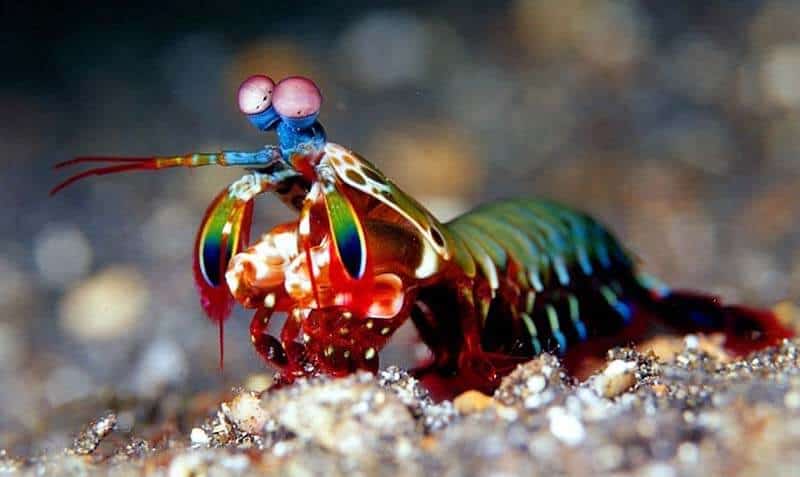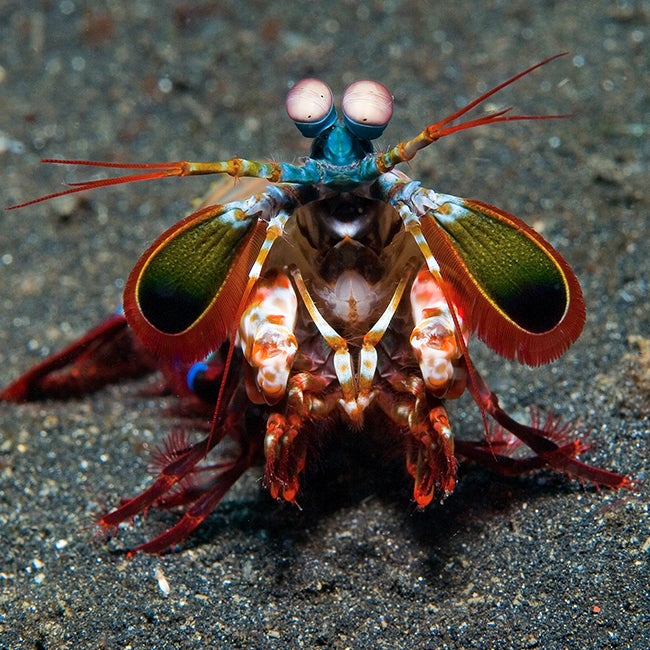Odontodactylus scyllarus, commonly known as the peacock mantis shrimp, harlequin mantis shrimp, painted mantis shrimp, clown mantis shrimp or rainbow mantis shrimp, is a large stomatopod native to the epipelagic seabed across the Indo-Pacific, ranging from Guam to East Africa, and as far South as Northern KwaZulu Natal in South Africa.

O. scyllarus is one of the larger, more colourful mantis shrimps commonly seen, ranging in size from 3–18 cm (1.2–7.1 in). They are primarily green with orange legs and leopard-like spots on the anterior carapace.
Their ability to see circularly polarised light has led to studies to determine if the mechanisms by which their eyes operate can be replicated for use in reading CDs and similar optical storage devices.

The dactyl club is the most electron dense region of the stomatopod exoskeleton. From a transverse cross section, the club can be divided into three different regions: the impact region, the periodic region and the striated region. The mechanical properties of each region has a correlation to the degree of mineralization that is present.
There is a step-like decrease in calcium concentration from the impact region towards the periodic region of the dactyl club, meanwhile the phosphate concentration decreases in a gradient manner. Alongside this the carbon and magnesium concentrations increases in the same region, hence stipulating that the impact region is mainly composed of calcium phosphate while the rest of the club contains a combination of calcium phosphate and calcium carbonate. The impact region has shown to be mainly composed of hydroxyapatite, with a higher degree of crystallinity compared to that found in bovine bone.
Odontodactylus scyllarus is a burrower, constructing U-shaped holes in the loose substrate near the bases of coral reefs in water ranging from 3 to 40 metres (9.8 to 131.2 ft) deep.

O. scyllarus is a smasher, with club-shaped raptorial appendages. An agile and active intertidal and sub-intertidal predator, it prefers gastropods, crustaceans, and bivalves and will repeatedly deliver blunt force to the exoskeleton of its prey until it can gain access to the underlying soft tissue for consumption. It is reported to have a “punch” of over 50 miles per hour (80 km/h), the fastest recorded punch of any living animal. The acceleration is similar to that in a .22 LR bullet fired from a handgun (accelerations of over 100,000 m/s2 or 330,000 ft/s2 (more than 10,000 g), and speeds of over 20 m/s or 66 ft/s), with each strike packing 1,500 N (340 lbf) of force. The speed of a raptorial appendage’s strike causes cavitation bubbles to form. When those bubbles pop they release a large amount of heat, temporarily raising temperatures to near those at the surface of the sun and further weakening the armor of their prey. In addition, the surface of its hammer-claw is made up of extremely dense hydroxyapatite, laminated in a manner which is highly resistant to fracturing, and can break ordinary glass tanks. Its composition is being investigated for potential bionic use in material engineering.











